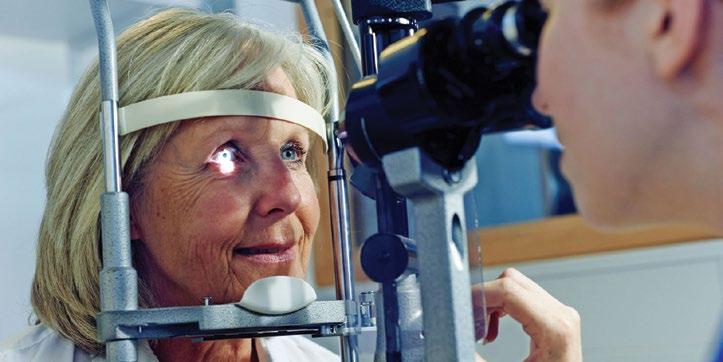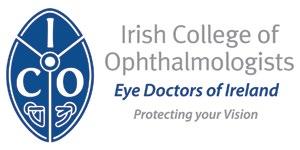
8 minute read
Coping wiith Cataracts
Coping with cataracts
The Irish College of Ophthalmologists (ICO), the training and professional body for eye doctors in Ireland, explain the condition, the symptoms and treatment options
What is a cataract?
The lens in the eye can become cloudy and hard, a condition called cataract. This interferes with the focusing power of the eye. Cataract can happen through ageing, as a result of eye injury, or if you have taken certain drugs such as steroids. Cataract is a common cause of visual impairment in older people but can also affect a small number of younger individuals.
Cataract causes blurred vision, dull vision, and sensitivity to light, glare and ghosting of images. If the cataract changes vision so much that it interferes with your daily life it may need to be removed. The only available treatment for removal of cataract is surgery to replace the affected lens. The purpose of the surgery is to remove the cloudy natural lens and replace it with a plastic lens (implant) inside your eye. A patient can decide not to have the cataract removed however the quality of their vision will continue to dis-improve. It is important if you suspect you might have a cataract to see an eye doctor who will discuss the condition and treatment options.
How this air balloon would be seen by healthy eyes and eyes with cataracts

tral core of the lens. This develops quite slowly sometimes taking many years to affect the vision significantly.
A cortical cataract occurs in the peripheral part of the lens and often looks like the spokes in a bicycle wheel. It takes some time for these ‘spokes’ to grow centrally to affect the vision and doctors often see signs of this cataract before the patient’s vision is affected.

people with diabetes and those on steroid therapy. This causes a ‘stippling’ on the surface of the lens like a semi-opaque bathroom window and can occur quite quickly sometimes blocking off the vision within a year.
What are the symptoms of cataract?
The blurring of vision is gradual, hardly affecting the sight at first. It would seem like looking through an opaque glass at times. Light from the sun, a lamp or oncoming headlights cause dazzle and in daylight colours seem faded. Patients often remark that colours are more vibrant in one eye than the other.
Symptoms and their onset may vary depending on the cataract type. With nuclear cataract for example there may be an improvement in reading and close work for many months or even years, due to the development of short sightedness, but eventually this will also deteriorate as the cataract progresses. This phenomenon used to be known as ‘second sight’. Subcapsular cataract can occur rapidly and affect the vision in a shorter period of time than other types of cataracts. If you suspect you are developing a cataract, you should make an appointment with your GP who will make a referral for you to see an eye doctor.
What are the causes of cataract?
Despite many studies, it is unknown exactly why cataracts form as the lens ages. While the factors are being gradually identified, it is thought that a diet with high antioxidants (beta-carotene, vitamins A, C and E, and selenium) may help keep cataracts at bay.
The following are risk factors that are said to be associated with cataract formation.
1. Ultraviolet light has been said to damage the proteins in the lens and induce cataract. Eye doctors advise the use of sunglasses and widebrim hats to protect against UV light exposure. A UV protective coating on your sunglasses is probably a good thing to have.
2. Poor nutrition. 5. Diabetes mellitus There is evidence to show that diabetics are more prone to cataract formation especially those suffering from Type 2 diabetes.
How is cataract treated / are there alternatives to surgery?
At an early stage, the impact of the cataract on your vision can be improved by changing the power of your glasses, that is, ensuring that your distance and reading glasses are up to date. Sometimes a change of glasses can give a temporary improvement of sight particularly if your cataract is at an early stage of development. Tinted lenses, magnifying lenses and appropriate lighting may also help.
This can go on for years at a time and an annual review is indicated. Later as the cataract becomes more opaque the only effective treatment is surgery.
When should I have my cataract removed?

Senior Times l May - June 2020 l www.seniortimes.ie 27 This depends on your personal circumstances and lifestyle. If you are a car driver, removal of the cataract will be indicated at a much earlier stage than for people who don’t drive. In Ireland, a binocular vision of 6/12, adequate contrast sensitivity and a normal field of vision is necessary for driving. Driving is very important to most people and to their independence, so if the above parameters are being threatened by cataract formation then early surgery is indicated.
However, if you don’t drive or are happy to give it up, and you have adequate vision to carry out your normal daily activities then cataract surgery can be postponed indefinitely. If you are happy with your current vision then there is no need to undergo cataract surgery. There can be many years difference in the timing of cataract surgery depending on your lifestyle or circumstances but it is important to keep regular appointments with your eye doctor so the condition can be monitored.
What does a cataract operation entail?
Cataract surgery is usually done as a day case procedure, however, in some cases your surgeon may prefer you to stay overnight in hospital after the surgery.

Before surgery, the eye is measured to help choose the correct strength of lens to replace the natural lens. In the operating theatre the pupil of the eye will be enlarged with drops and the eye anaesthetised with drops, and sometimes with an infusion of anaesthetic into the space between the eyeball and the lids to reduce movement of the eye. Alternatively your surgeon may decide that the procedure should be done under intravenous sedation or general anaesthetic if you are very anxious.
The operation will be done by an experienced eye surgeon using an operating microscope and very fine instruments in a hospital theatre setting with a medical team. The patient does not see what is happening but will be aware of bright light and warm water around the eye. Local anaesthetic lasts around 20/30 minutes, the length of time it takes to complete the operation.
The eye is opened and a small hole is made in the capsule (bag) that contains the cataract. The cataract is broken into small pieces and “hoovered” out of the eye, a process that is called Phacoemulsification. The lens implant is then injected into the capsule. Antibiotics are administered and the tiny wound is made secure. You will be asked lie still until a protective pad and/or shield is placed over the eye.
Cataract surgery is one of the highest volume surgical procedures carried out in Ireland featuring in the top 20 day case procedures performed annually in public hospitals since 2005.
Post-operative care
Most patients recover very quickly following cataract surgery. The protective cover will remain in place for a number of hours and your doctor or nurse will advise the patient when it can be removed. Patients will also receive advice about how to care for the eye following the procedure to protect against infection and inflammation and antibiotic and anti-inflammatory drops will be prescribed. A patient will return for follow up one week after surgery but will be given an emergency number to contact the clinic should any undue soreness or blurring occur the days following discharge.
Many recommence driving after one to two weeks and will have returned to normal activities such as work after a week or two.
How to make an appointment with an eye doctor
For an appointment to see any medical specialist working in the HSE, including eye doctors, you need to get a referral from your General Practitioner (GP). A GP has knowledge of the specialists in his/her area and can ensure that any important information relating to your medical history is passed to the eye doctor.
Can I make an appointment directly with an eye doctor?
While it is advisable to seek a referral from your GP many eye doctors working in the community will give you an appointment directly - you can find contact details for eye doctors on the ICO website at www.eyedoctors.ie
How to take care of your eye health
The ICO places a priority on raising the public’s awareness of eye health and the significance of eye health as an indicator of general health and wellbeing.
The eye is not an isolated unit and has complicated relationships with numerous other bodily functions including that of the brain and nervous system. Often when an eye problem presents, it can be an indicator of another underlying medical condition.
Many eye diseases are associated with general medical conditions and many general systemic conditions affect eye health (diabetes, sleep apnoea, various tumour’s, hypertension, sickle cell disease, lupus, and many others can affect the eyes and threaten vision).
People need to be aware of how important lifestyle is for good eye health and the importance of reacting to any change they notice to their sight. After ageing, smoking is the biggest risk factor for developing Age related-Macular Degeneration and also increases your risk of developing cataracts.
Simple lifestyle changes can have a big impact and help to slow the progression or onset of eye conditions, like giving up smoking, eating a healthy diet rich in leafy greens, exercise, sensible use of sunglasses and having regular eye exams.
It is important to make an appointment to see an eye doctor or a health care professional if you notice a change, however slight in your vision.
For more information on eye health, visit the ICO website at www.eyedoctors.ie











